The Milky Way galaxy is an immense, flat, disk-shaped collection of gas, dust, and stars that spreads around 100.000 light-years across and is several thousand light-years thick.
Key Facts & Summary
- There are at least 100 billion galaxies in the universe, and the Milky Way is just one of them.
- The Milky Way – out of the four types of galaxies – is a spiral barred type of galaxy.
- Every star we see with our naked eyes is in the Milky Way galaxy. The only object you can see in the sky outside of the Milky Way with your naked eyes is the Andromeda Galaxy.
- The ancients knew about the Milky Way, but they did not know what it was exactly. In 1610 Galileo Galilei pointed his telescope in the sky and saw thousands of stars. More observations were conducted and after the discovery of the Andromeda galaxy by Edwin Hubble, it was concluded that the Milky Way was just one out of many galaxies.
- The galactic center of the Milky Way is about 25.000 light-years away from our Sun.
- In the galactic center lays Sagittarius A*, a supermassive black hole that has a mass of about 4.3 million that of our Sun. This is a common feature of the galactic centers of galaxies.
- Sagittarius A* is about the size of Mercury’s orbit – 22.5 million km / 14 million mi. This is just the hole itself, the accretion disk which is the mass of objects trying to get into it is responsible for Sagittarius’s enormous mass.
- The Milky Way has been estimated to have around 100 million black holes, but not as gigantic as the one in the center.
- The mass of the Milky Way is believed to be around 100 billion times that of the Sun, which would translate to the fact that our galaxy might have around 100-400 billion stars.
- The radius of the Milky Way is estimated to be around 52.850 light-years.
- The Milky Way is believed to be around 12 billion years old.
- There are around 40 billion exoplanets (planets that orbit other stars) similar to the size of Earth orbiting in the habitable zones of their sun-like stars. At least 100 billion planets exist in the Milky Way galaxy.
- The Milky Way galaxy has 4 major spiral arms, which are sights of strong star formation.
- There are many more minor spiral arms as well. Our Sun is currently in such a location, just outside a spiral arm named the Orion Arm.
- The Milky Way is made up of about 90% dark matter, matter that cannot be seen and about 10% “luminous matter”, or matter that we can see with our eyes. This large quantity of dark matter causes an invisible halo that has been demonstrated by simulations of how the Milky Way spins.
- The halo – is a vast spherical cloud of stars surrounding us out at great distances. Most of the globular clusters – groups of the most ancient stars in the universe orbiting the Milky Way - are in this halo, orbiting the Milky Way’s galactic center.
- The central region of the Milky Way is shaped like a bar, composed of mostly old, red stars.
- Our galaxy belongs to a small cluster of galaxies called the Local Group, which is one of many other groups and clusters of galaxies located near the outer edge of the Virgo supercluster.
- Our galaxy grew by devouring other small galaxies. Such a process is still on-going even now. The Large and Small Magellanic Clouds are orbiting the Milky Way galaxy, while the Sagittarius dwarf galaxy is on the process of merging with the main body of the Milky Way galaxy.
- Estimative calculations predict that our galaxy will also collide with the Andromeda galaxy in around 8 billion years or sooner.
- The Milky Way galaxy is moving at a velocity of 600 km / 372 mi per second towards a densely packed region of space called the Shapley Attractor. In comparison to the size of the galaxy, the accurate speed of movement is actually smaller.
- In addition to the pulling effect of the Shapley Attractor, the Milky Way galaxy is also pushed by the Dipole Repeller – an empty void.
- The oldest known exoplanet in the Milky Way galaxy is nicknamed Methuselah – believed to be about 12.7 billion years old.
- About 10-15% of the Milky Way’s visible matter is made of dust and gas, with the rest being stars.
Since ancient times humanity has been able to observe a faint fuzzy glow stretching on the night sky. This glow’s resemblance to a pathway or a river is strong. Many ancient cultures saw it that way because it glows white.
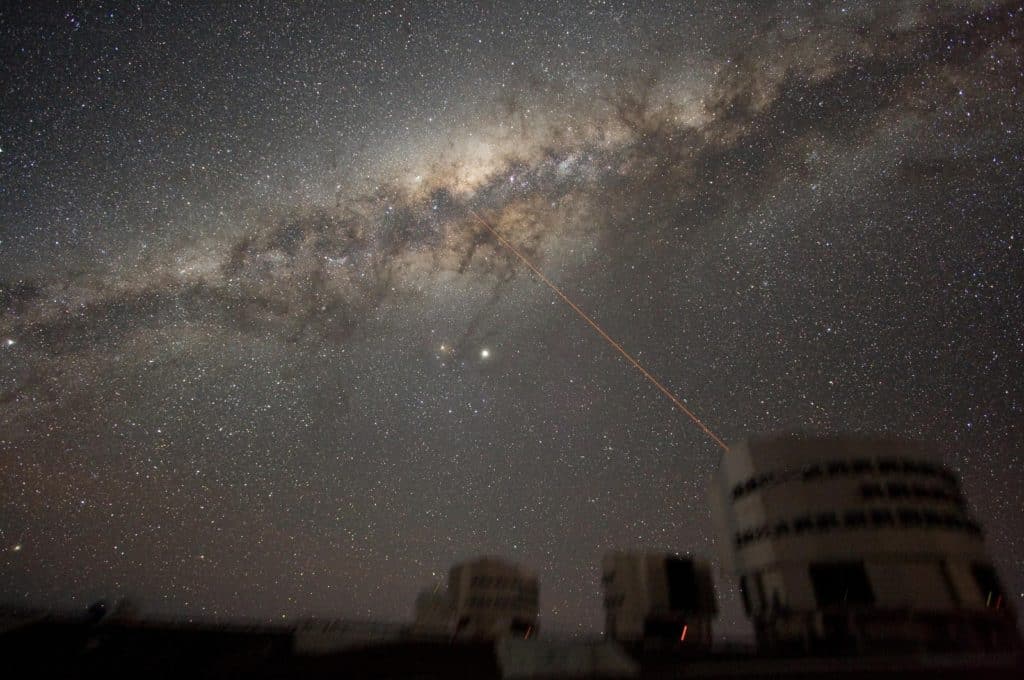
The ancient people of Greece called it “Galaxius”, or “Milky.” Over the millennia that name remained and suffered different variations, and stuck to this day.
Nobody knew what exactly this glow was, until Galileo Galilei pointed his telescope at it in 1610, and saw that the glow was actually a collection of thousands of stars. For a period of time, some believed that the galaxy is as big as the universe itself. However, many observations were further conducted.
Since the Andromeda galaxy can also be viewed with the naked eyes, it attracted the attention of astronomers. With more modern telescopes being used, an astronomer by the name of Edwin Hubble studied the Andromeda nebula. He concluded in 1923 that the nebula was, in fact, another galaxy.
He published his works in 1929 and forever changed our views on the universe, concluding that the Milky Way was just one, out of many other galaxies. Seven decades later, a telescope named in Hubble’s honor helped discover that the observable universe was truly vast, and contained nearly 100 billion galaxies.
Formation
How the Milky Way formed is still a matter of debate. The Big Bang theory suggests that after the explosion, the universe was composed of radiation and subatomic particles.
There are two strong viewpoints here:
- Small particles slowly teamed up and gradually formed stars, star clusters, and eventually galaxies.
- The universe first organize as immense clumps of matter that later subdivided into galaxies.
It is still up to debate. However, we know that the Milky Way galaxy grew by merging with other galaxies. Almost half of the matter in the Milky Way is believed to have come from other distant galaxies.
These very old stars and clusters now comprise the galactic halo of our galaxy. It continued to grow by merging and because of the accretion of gas that came directly from the galactic halo.
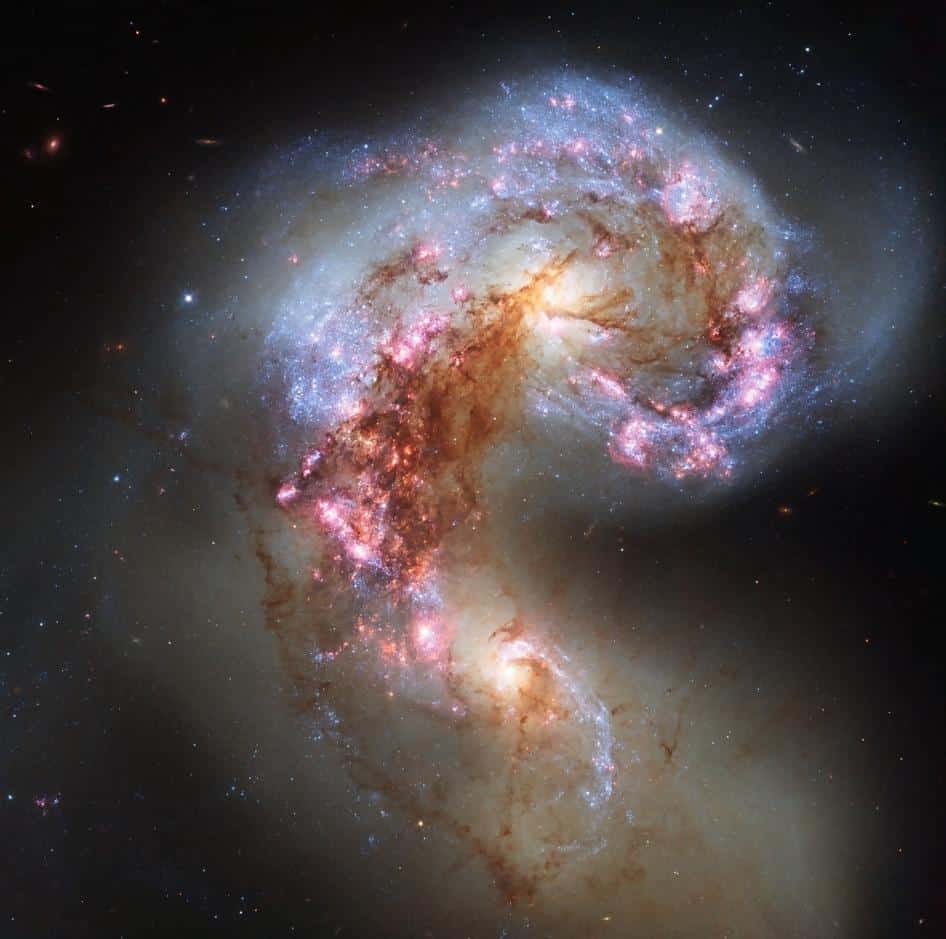
When the first stars of the Milky Way were born, the mass was large enough so that the galaxy was spinning relatively quickly.
This led the gaseous interstellar medium to collapse from a roughly spheroidal shape – to that of a disk. Later-generation of stars formed in this spiral disk, with the younger stars including our Sun, currently observed to be in the disk.
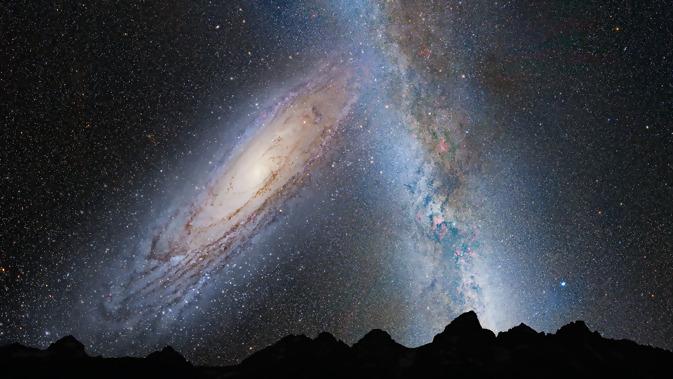
Location
The Milky Way galaxy and the Andromeda galaxy are a binary system of giant spiral galaxies belonging to a group of 50 closely bound galaxies known as the Local Group
The Local Group is surrounded by a Local Void, itself being part of the Virgo Supercluster of galaxies. The Virgo Supercluster is also surrounded by giant voids such as the Microscopium Void, Sculptor Void, Bootes Void, and Canes-Major Void.
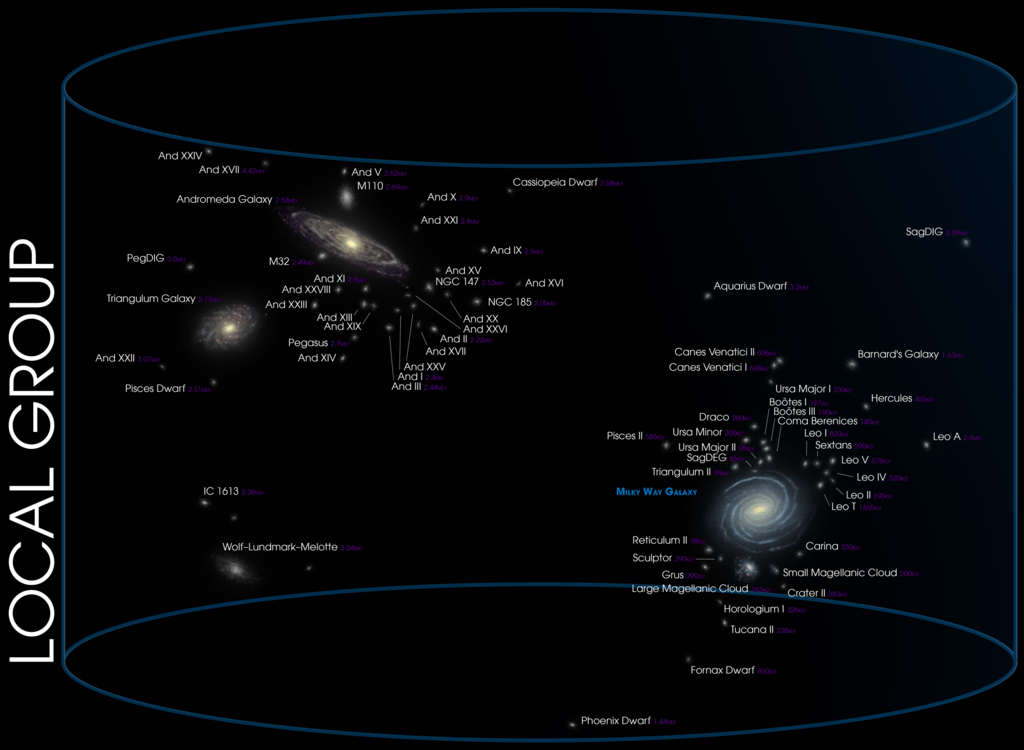
The voids change shape over time, creating filamentous structures of galaxies. The Virgo Supercluster, for instance, is being drawn towards the Great Attractor, which in turn forms part of a greater structure named Laniakea.
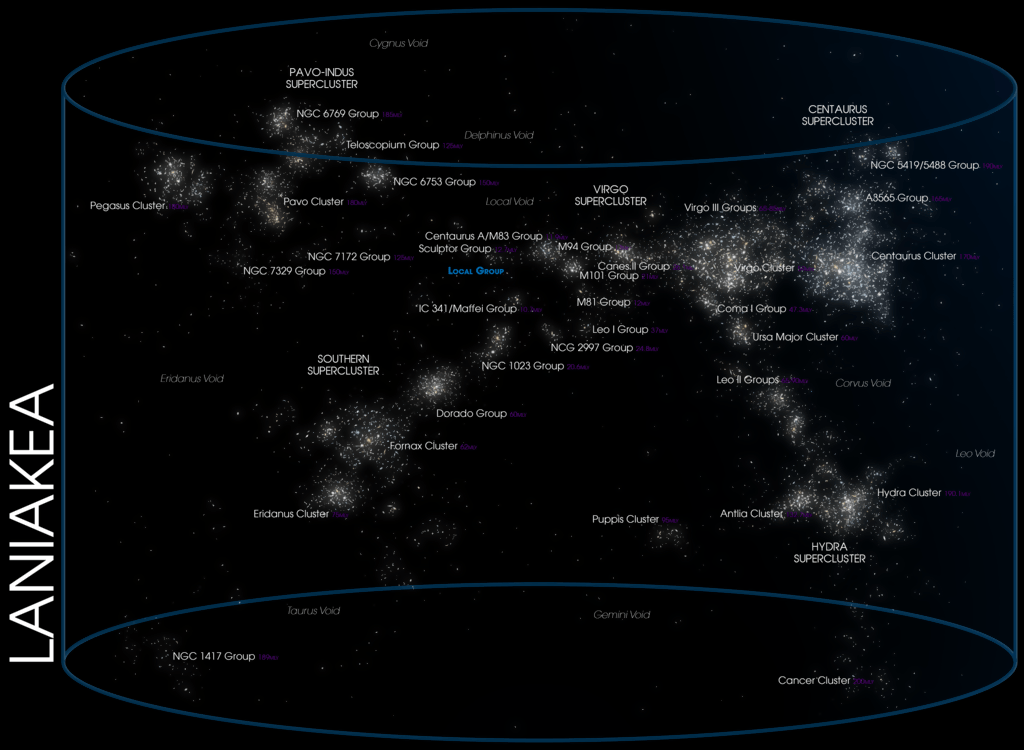
Size, Mass, and Distance
The Milky Way is part of the Local Group, holding the second title as the largest galaxy in it. Its stellar disk is approximately 100.000 light-years / 30 kpc in diameter.
It is approximately 1.000 light-years / 0.3 kpc thick. The Local Group is about 10 million light-years across, and the Andromeda galaxy is the most massive galaxy in it, The Milky Way is the second-most massive.
The Milky Way is almost 1.5 trillion times the mass of the Sun. If the Solar System were the size of a coin, the Milky Way would be the size of the contiguous United States.
Much of the mass seems to be dark matter, an unknown and invisible form of matter that interacts gravitationally with ordinary matter.
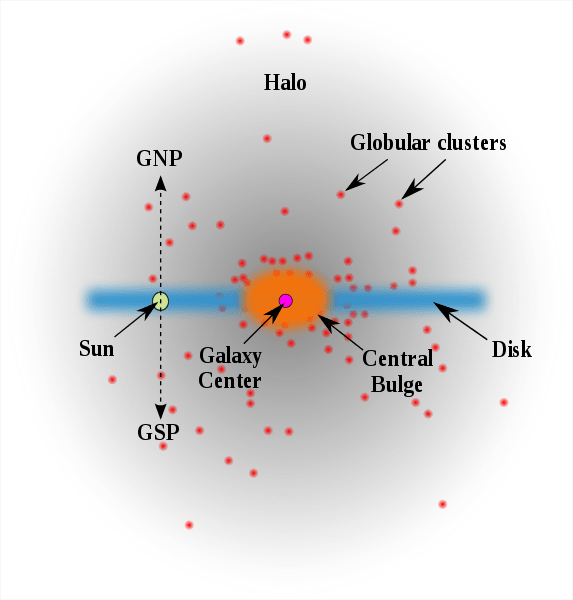
Milky Way’s mass has a radius of about 129.000 light-years. This suggests that about 90% of the mass is comprised of dark matter.
Galactic Rotation/Orbit
All the stars and gas of our galaxy orbit a supermassive black hole located at the center of the galaxy named Sagittarius A*.The Sagittarius A* is around 28.000 light-years away from Earth.
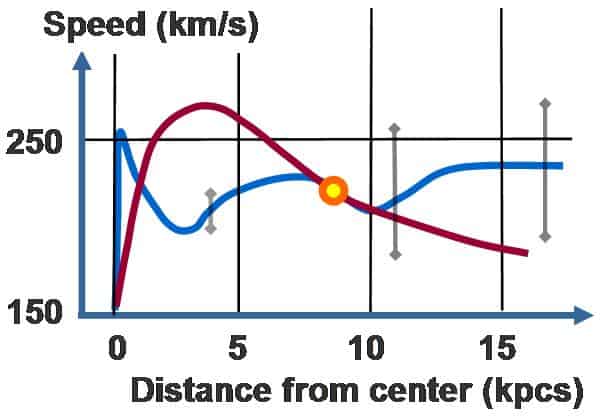
The stars and gas rotate around the center differentially, meaning that the rotation period varies with location. A typical characteristic of spiral galaxies is that the orbital speeds of most stars do not depend strongly on their distance from the center.
There are 2 small galaxies around with a number of dwarf galaxies in the Local Group who orbit the Milky Way. The largest one is the Large Magellanic Cloud with a diameter of 14.000 light-years. It has a close companion, the Small Magellanic Cloud. The smallest galaxies usually have 500 light-years diameters.
Structure & Contents
The Milky Way consists of a bar-shaped core region that is surrounded by a warped disk of gas, dust, and stars. It is a spiral galaxy with relatively loosely wound arms.
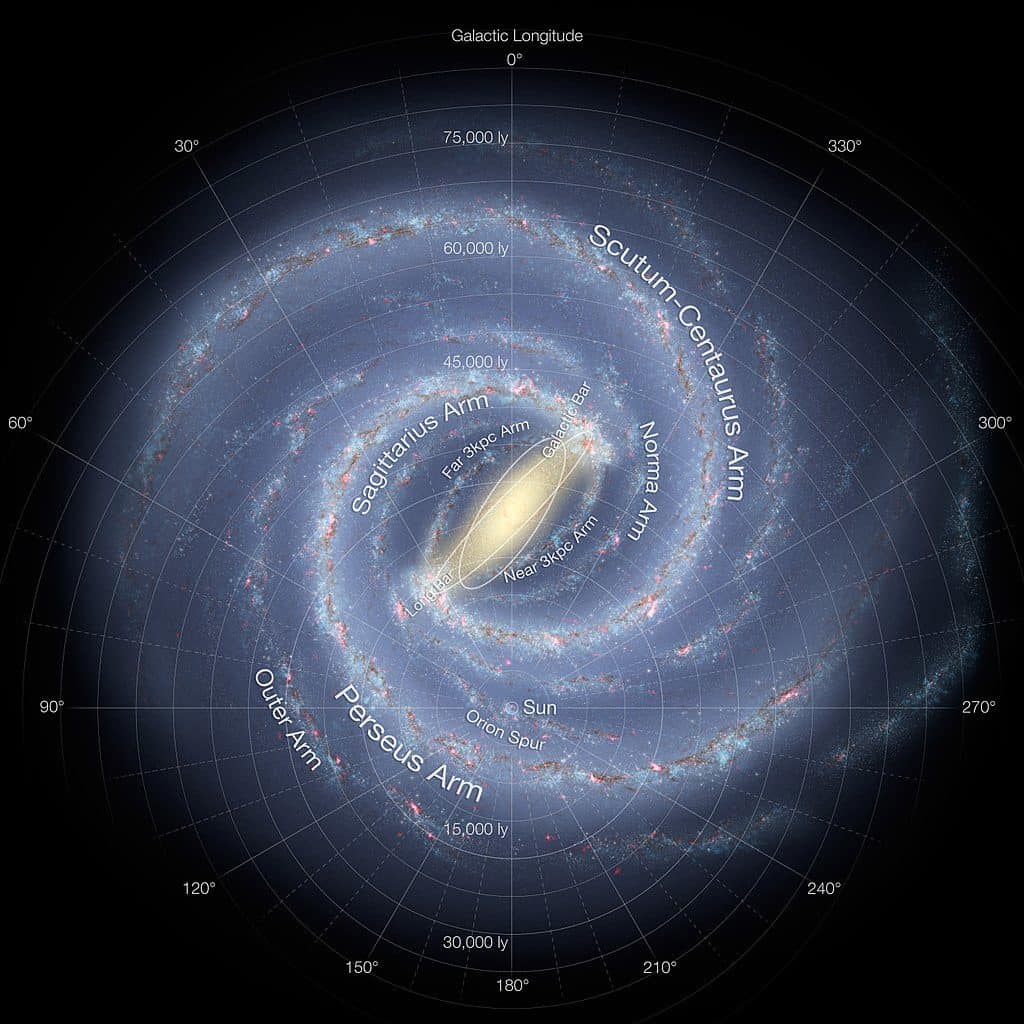
The Milky Way galaxy has 4 major spiral arms, which are sights of strong star formation.
There are many more minor spiral arms as well. Our Sun is currently in such a location, just outside a spiral arm named the Orion Arm.
The Milky Way is made up of about 90% dark matter, matter which cannot be seen and about 10% “luminous matter”, or matter that we can see with our eyes. This large quantity of dark matter causes an invisible halo that surrounds the Milky Way.
Spiral Arms
The 4 major spiral arms of the Milky Way contain a higher density of interstellar gas, dust and a greater concentration of star formation than the rest of the galaxy.
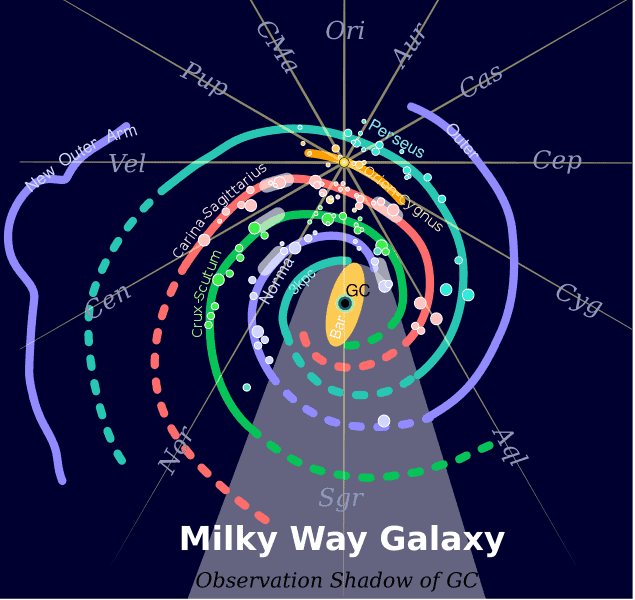
The cyan, purple, green, and pink colors represent the major arms. They are called: the Perseus Arm, Outer Arm, Scutum-Centaurus Arm, and Carina-Sagittarius arm.
The orange color represents the two minor arms which also contains our solar system. They are the Orion and Cygnus Arm. The investigation is on-going to determine the exact number of arms our galaxy has.
Black holes
In the center of the Milky Way is Sagittarius A*, a supermassive black hole. It has a mass of about 4.3 million that of our Sun and it is near the border of the constellations Sagittarius and Scorpio.
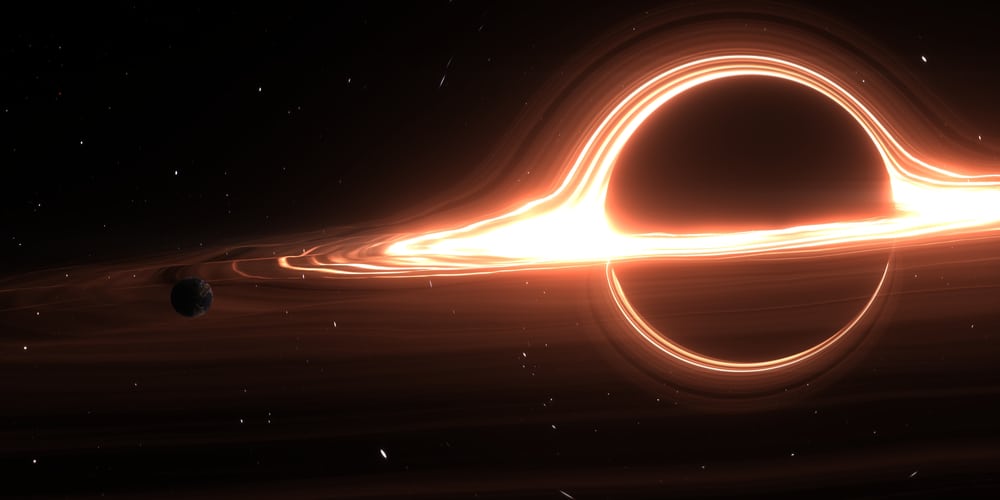
Sagittarius A* is not the only black hole in the Milky Way. Estimations suggest that there are over 100 million black holes in the Milky Way alone with two dozen already discovered, but they are small.
However, recent observations of a star named LB-1 revealed the presence of a black hole about 70 times or more the mass of our Sun. This discovery is controversial since it was believed that there shouldn’t be black holes of this size in our galaxy, with the exception of Sagittarius A*. Observations continue and now a raising belief is becoming predominant: that there are more enormous black holes of which we haven’t yet detected in our own galaxy.
Halo
The Milky Way’s galactic disk is surrounded by a spheroidal halo of old stars and globular clusters. About 90% of them lie within 100.000 lights years of the Galactic Center. Almost 40% of the clusters in our galaxy are on retrograde orbits, moving in the opposite direction from the Milky Way rotation.
Stars
The Milky Way contains hundreds of billions of stars of all different types, shapes, and sizes. Filling the space between the stars is a disk of gas and dust called the interstellar medium. This disk has at least a comparable extent in radius to the stars.
Stars are still birthed in our galaxy with an estimated one new Sun’s mass worth of stars being formed per year. This mostly occurs in the dense clouds in the galactic plane, central bulges, and even some of the outskirts of the galaxy.
The closest star to us (with the exception of our sun), is a star named Proxima Centauri, at about 4.3 light-years the average distance.
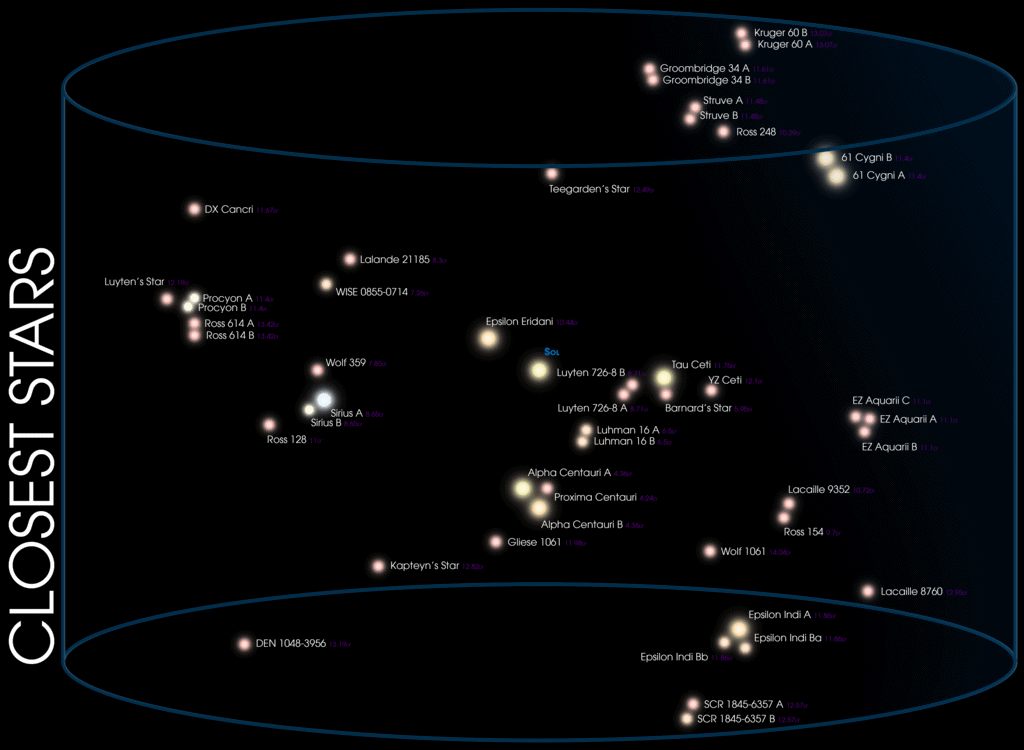
Perhaps the oldest star in the Milky Way that we have detected, is a star named SMSS J0313-6708. It is estimated to be 13.6 billion years old at a distance of 6.000 light-years from Earth. Another star designated HD 140283 is considered to be older, but there is uncertainty regarding its age.
Thus, this makes SMS0313 the oldest known star with an accurate determination of its age.
In regards to the largest known star in the Milky Way, it is believed to be the Pistol Star. It is a star believed to be 100 times more massive than our Sun and 10.000.000 times as bright.
Exoplanets
Exoplanets are planets that orbit other stars, just like the planets in our solar system orbit the Sun. There are around 4.099 confirmed exoplanets in the Milky Way. Another 5.000 are awaiting confirmation and more than 3.000 planetary systems have been confirmed.
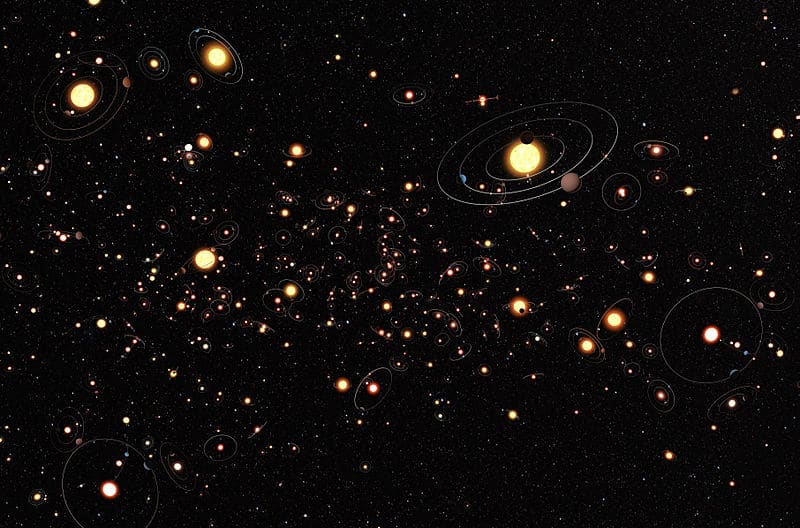
The Milky Way is estimated to have billions of planets, some of them orbiting stars while others drifting alone in space bearing the name “rogue planets.” The oldest known exoplanet in the Milky Way galaxy is nicknamed Methuselah (PSR B1620-26b) – believed to be about 12.7 billion years old. It is approximately 12.400 light-years away from Earth, and it is located in the constellation of Scorpius.
Life Habitability
There are an estimative 40 billion Earth-sized planets in the Milky Way, orbiting around sun-like stars and positioned in the habitable zone. This coupled with the fact that even moons may have suitable conditions to develop life, drastically raises the chances of life outside our own planet. But obviously enough, we ourselves are the proof that the Milky Way galaxy is at least favorable towards developing life.
Collision
Galaxies grow by colliding and thus merging with other galaxies. The Milky Way is no different. Some galaxies have already been absorbed by the Milky Way, such as the progenitor of Omega Centauri.
It is strongly believed that the Milky Way will collide with the Andromeda Galaxy in the far future. Current measurements suggest that the Andromeda galaxy is approaching us at 100 – 140 km/s ~ 62-86 mi/s.
Future observations
There isn’t actually any photo or illustration of the Milky Way that is complete. Observations are continuous and every day they reveal new planets, stars, facts. But step by step, we will one day have a more complete view of our own galaxy. Much of it still remains unknown.
Did you know?
- Our Sun takes around 250 million years to orbit the galaxy. This means that it’s already made about 20 orbits around the galaxy since it was born.
- In an interesting way, we all orbit around a black hole, the one in the galactic center of the Milky Way, Sagittarius A*.
- It is believed that the Milky Way galaxy has around 2 rogue planets for every star. They are planets that have been thrown out of their solar system.
- The Milky Way is rotating in a clockwise direction.
- The Milky Way is surrounded by more than 150 ancient groups of stars, some of which are among the oldest in the universe. They are called globular clusters.
- We have only around 75 years since we discovered that we live in a galaxy, out of many other galaxies.
- The outermost regions of the Milky Way suggest that it hasn’t undergone any mergers with large galaxies in the last 10 billion years. This is unusual when compared to other similar spiral galaxies like our own - Andromeda for example.
Source:
Image source:
- https://upload.wikimedia.org/wikipedia/commons/4/43/ESO-VLT-Laser-phot-33a-07.jpg
- https://phys.org/news/2016-10-galaxies-collide.html
- https://upload.wikimedia.org/wikipedia/commons/thumb/9/90/06-Local_Group_%28LofE06240%29.png/1024px-06-Local_Group_%28LofE06240%29.png
- https://upload.wikimedia.org/wikipedia/commons/8/81/07-Laniakea_%28LofE07240%29.png
- https://upload.wikimedia.org/wikipedia/commons/thumb/c/c3/Milky_way_profile.svg/573px-Milky_way_profile.svg.png
- https://upload.wikimedia.org/wikipedia/commons/7/77/Rotation_curve_%28Milky_Way%29.JPG
- https://upload.wikimedia.org/wikipedia/commons/thumb/1/12/Artist%27s_impression_of_the_Milky_Way_%28updated_-_annotated%29.jpg/1024px-Artist%27s_impression_of_the_Milky_Way_%28updated_-_annotated%29.jpg
- https://upload.wikimedia.org/wikipedia/commons/thumb/1/1d/Milky_Way_Arms.svg/635px-Milky_Way_Arms.svg.png
- https://asgardia.space/en/news/asgardia-space-news-new-research-confirms-that-sagittarius-a-is-the-center-around-which-the-entire-milky-way-galaxy-rotates
- https://upload.wikimedia.org/wikipedia/commons/thumb/0/0c/04-Closest_Stars_%28LofE04240%29.png/1024px-04-Closest_Stars_%28LofE04240%29.png[12.]
- https://en.wikipedia.org/wiki/Exoplanet#/media/File:Planets_everywhere_(artist%E2%80%99s_impression).jpg
